Green industry
Green industry in Portland and Oregon
NOTE Utility-scale, alternative power in Oregon and Portland, solar and wind energy providers, and green building leadership in Portland are overviewed here, but many smaller "green" or sustainable-focused firms have not (yet) been listed or described.
Introduction
Oregon and Portland is becoming a green energy hub,[1][2] with utility scale energy generation using Wind, Solar and Wave, investments in electric car charging infrastructure, batteries and inverter technology, and a green building hub providing leadership nationwide.
Sustainable Utility Power in Oregon
Oregon's legislature passed a law in 2007 that requires utilities to get at least 25 percent of Oregon's power from renewable sources by 2025.[3] For 10 years beginning March 2002,[4] Portland General Electric (PGE) and Pacific Power customers pay a 3 percent charge on their monthly bills for conservation and renewable resource programs under Oregon's electric industry restructuring law. About 17 percent of the funds, estimated at $10 million to $13 million per year, are for projects that generate electricity from renewable resources. The Energy Trust of Oregon administers the funds. Its goal for renewable resources is that they supply 10 percent of the state's electricity needs by 2012, an eight-fold increase.
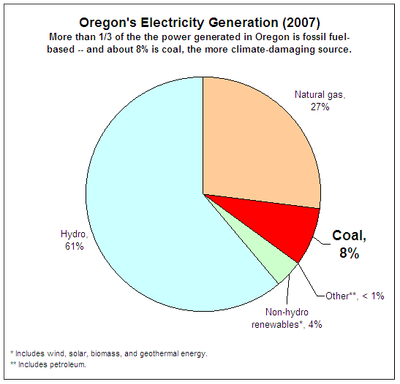
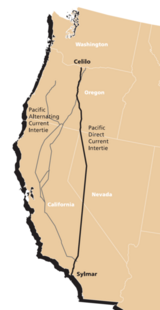
The U.S. is on a trajectory to generate 20% of the nation’s electricity from wind energy by 2030.[5] Wind and solar can be cheaper than hydro, nukes or coal,[6] but renewables have more variables (like sun and wind) and can't store power (like a dam), or deliver on-demand power (like fossil fuel, hydro or nuclear). The U.S. spends about $1 billion a day importing oil, which is now over $100 a barrel, according to Energy Secretary Steven Chu.
Power companies are provided with incentives by the federal government to get off dirty coal, often used to generate electricity, or natural gas, which is a limited resource. Dams are excellent power generators, but the Columbia River is nearly tapped out. Fishing issues and river transportation are also problematic.
The Dalles Dam, constructed by the federal government in 1957, is one of the largest "renewable" energy sources. It produces close to 1,800 megawatts of hydro power. The Grand Coulee Dam is the largest electric power-producing facility in the United States and fifth largest producer of hydroelectricity in the world (2008), producing 6.8 Megawatts. The Pacific DC Intertie, on Bonneville's grid, connects to Los Angeles with a line capacity of 3,100 megawatts.
Reducing dependency on foreign oil is a major thrust. So is attracting dollars. The Federal Department of Energy, the State of Oregon and Portland aim to provide leadership in "green energy" and become a hub for sustainable innovations. Oregon is an energy exporter, through Bonneville, and tied into the grid. We also have the Pacific Ocean, wind, and semi-conductor expertise for solar.
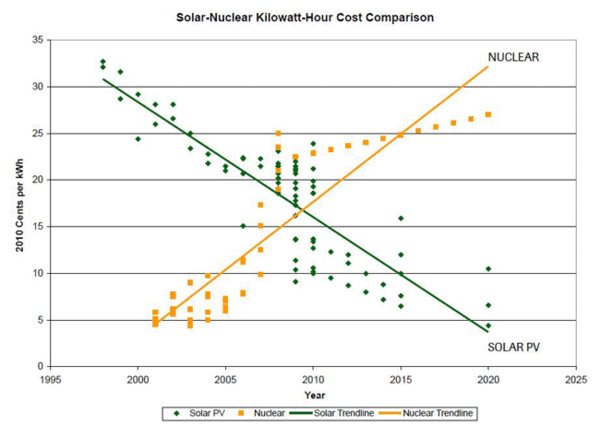
Grid parity has been reached in Hawaii, where electricy costs around $.30 per Kilowatt hour (it's less then $.10 in Oregon). Most of the US is expected to reach grid parity by 2015, says Wikipedia. Grid Parity is when renewable energy costs are equivalent to non-renewables such as coal or oil.
Wind Farms in Oregon
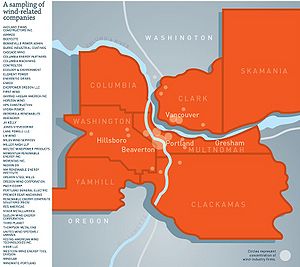
PGE, the state's largest utility, hopes to shut down the state's only coal-fired power plant 20 years earlier than planned. PGE has natural gas and coal-fired power plants in Boardman and has proposed one or two additional natural gas plants there, if it closes its Boardman coal plant to meet haze-reduction rules or avoid carbon taxes. The 585-megawatt coal fired plant provides enough electricity to serve about 250,000 residential customers.
About 4 percent of PGE's energy comes from wind farms — mostly the Biglow Canyon Wind Farm, plus power PGE purchases on contract from the Klondike II and Vansycle Ridge wind farms. The Stateline Wind Farm runs along the Columbia River.
- Portland General Electric’s Biglow Canyon Wind Farm is the second-largest wind energy facility in the state. Biglow's 141 Vestas wind turbines produce 275 megawatts of power. The wind farm is located in Wasco County, near The Dallas, an area likely to get further wind development, despite growing community concern about noise and environmental impacts. The $1 billion project was completed in September, 2010. Vestas, the largest wind turbine manufacturer, has its North American headquarters in Portland. Here's a video tour of a Vestas tower at Biglow and Sam Churchill's Flickr photo collection of Bigelow (below).
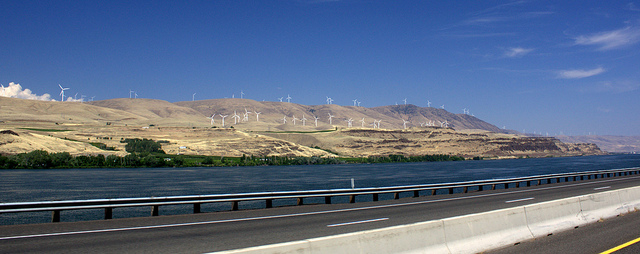
- Shepherds Flat Wind Farm, a planned 845 megawatt wind farm near Arlington, Oregon, may be the world's largest. Installation of the wind turbines is scheduled to begin in 2011 and is expected to be fully built in 2012. Planned to be built by Caithness Energy, it would supply electricity to Southern California Edison. The wind farm is projected to be the largest land-based wind farm in the world when it is completed. The V90-3.0 MW turbines would be manufactured by Vestas.
- Eastern Oregon wind farms, especially the Summit Ridge wind farm in Wasco County, have now been thrown into doubt. In September, 2010, the U.S. Fish and Wildlife Service recommended that the Oregon Department of Energy allow wind turbines no closer than 6 miles to a golden eagle nest. That has also prompted Portland General Electric to back off its push to buy development rights for a massive new wind farm near Arlington in Gilliam County.
- In December, 2010, The U.S. Department of Energy finalized a $1.3 billion loan guarantee for the Shepherds Flat wind farm. The 845-megawatt Shepherds Flat wind farm is said to be the largest in the world when completed in a couple of years. The power generated by the farm will be sold directly to Southern California Edison through 20-year fixed price power purchase agreements. Construction of the Shepherds Flat Wind Farm is expected to create 400 jobs, with 35 permanent jobs supported on site once its created.
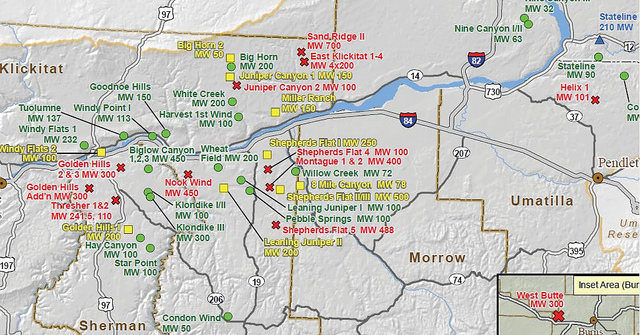
Iberdrola Renewables, headquartered in Portland, Oregon, is the second largest provider of wind in the country has 41 wind farms in the United States with an installed capacity of 3,877 megwatts, enough to power close to 1 million average U.S. households. Klondike Wind Power, a subsidiary of Iberdrola Renewables, sells power to the Bonneville Power Administration.
Sales of small wind turbines (100 kilowatts and less) in the U.S. grew from 2,100 units in 2001 to 9,800 units in 2009 (peak has been 10,386 in 2008), according to the American Wind Energy Association. Electrical power is relatively cheap in Oregon (7 cents a kilowatt hour, compared to 29 cents in Hawaii) so often Oregonians who buy small wind turbines, especially for homes, aren't trying to save money but rather to invest in renewable energy and/or attain some energy independence.
Xzeres, a small-wind turbine manufacturer, is in Wilsonville. Oregon Wind's small vertical Helyx is designed and manufactured in Portland, using locally sourced recycled materials.
As of November 2010, the two largest wind farms are in Texas; the 781.5 MW Roscoe Wind Farm is the largest in the world, followed by the Horse Hollow Wind Energy Center at 735.5 MW. The largest wind farm under construction is the 800 MW Alta Wind Energy Center in California. The largest proposed project is the 10,000 MW Gansu Wind Farm in China.
Solar Power in Oregon
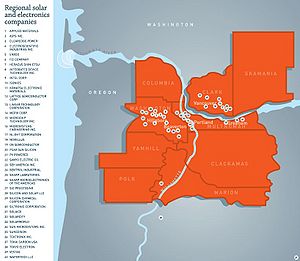
Crystalline silicon panels, like those made by industry leader SolarWorld in Hillsboro, Oregon, dominate 90% of the industry today. Silicon prices have dropped recently, making traditional Monocrystalline silicon more competitive, on a cost per watt basis, although competition from China is a constant worry.
The Portland region is positioning itself to be a production center for all three major photovoltaic technologies; Crystalline silicon, Cadmium Telluride and Copper Indium Gallium Selenide.
Thin-film technology has proved challenging to commercialize, although both major thin film technologies; Cadmium telluride and CIGS seem posed to provide a more streamlined production process, lowering costs.
Cadmium telluride panel manufacturers, like Solexant, in Greham, Oregon, claims they can manufacture solar panels for less than $1 per watt, while Startup CIGs developer SoloPower is is said to be eyeing Wilsonville for a manufacturing plant.
Whether thin films will represent a huge shift in energy economics remains to be seen.

Some of the Photovoltaic players in the Portland region include:
- SolarWorld, the largest manufacturer of solar panels in the United States. The company unveiled its 210,000-square-foot addition to its Hillsboro, Ore., manufacturing plant in 2010. It is now the only monocrystalline solar manufacturing plant in the United States to produce every phase of solar panel manufacturing. SolarWorld will collaborate develop a 11.6-megawatt solar system with the LA Department of Water and Power, using more than 46,000 solar modules on the 42-acre site. SolarWorld has been supported partly by tax incentives from the city of Hillsboro, the state of Oregon and the US government via the Recovery Act. SolarWorld Group has its main manufacturing operations in Hillsboro and in Freiburg, Germany.
- SANYO Solar, claims to manufacturer the world’s most efficient solar panels, and has opened a monocrystalline growing facility in Salem, Ore. The plant, spanning 130,000-square-feet at the Salem Renewable Energy and Technology Center and employing 200 highly skilled workers, represents an investment by SANYO of more than $84 million. Sanyo Solar grows crystals in Salem and slices them into wafers, which Japanese workers make into cells that go into panels in Japan, Hungary or Mexico.
- Cadmium Telluride developer Solexant, plans to build a $200 million solar manufacturing plant in Gresham. The company plans to construct a 100,000-square-foot manufacturing plant that will initially employ 100 before growing to 170 at full production. Long term, the company hopes to eventually expand the facility to manufacture panels capable of generating 1,000 megawatts. Solexant's facility in Oregon, producing 100-megawatts of thin film CdTe) solar panels annually, will be the largest nanotechnology manufacturing facility in the world. Long-term, the company hopes to expand the facility to 1000MW annually, reports Oregon Live. Such a facility could employ as many as 1,000 workers.
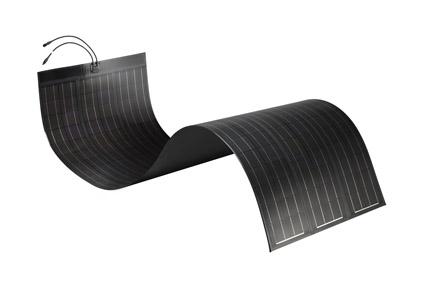
- CIGs developer SoloPower is building a manufacturing plant in Wilsonville. The $56 million manufacturing plant could employ 500 people within five years, says the company. SoloPower received a $197 million loan from the DOE, in February, 2011, to support construction of their Wilsonville plant. SoloPower's tough but flexible solar panels are said to enable inexpensive roof mounting. Their expansion plans call for three more manufacturing lines, growing the plant’s capacity to 300 megawatts and its employment to around 500. SoloPower also sought and received a $20 million loan from the Oregon Energy Loan Program.
- Grape Solar doesn't grow silicon crystals or make solar cells at its Eugene headquarters. Essentially, it just imports low-cost solar panels from China and re-sells them here.
Advanced Energy Systems is the leading commercial solar integrator in Oregon, with commercial solar energy systems for Lewis and Clark College, ODOT, Kettle Foods, Pepsi-Cola, and other Oregon businesses.

The nation’s first Solar Highway project (right) started feeding electricity into Portland's electricity grid on Dec. 19, 2008. PGE’s “Oregon Solar Highway” is a 100kW system that contains about 8,000 square feet of solar panels extending about the length of two football fields. It incorporates SolarWorld silicon PV array and the Solar Energy Grid Integration Systems (SEGIS), a DOE program to develop photovoltaic (PV) systems that seamlessly integrate into the distribution and transmission grid. The site doesn't store electricity - it just sells "green power" back to PGE.
Urban solar systems - with lots of grid power available - often skip expensive and troublesome battery storage. Power companies, provided with incentives to get off dirty coal, are willing to buy wind and solar generated power.
The SuNRISE lab contains $1 million of state-of-the-art equipment to analyze solar cells on the University of Oregon campus in Eugene. Solar is cheaper than nuclear energy, according to Duke University. iSuppli predicts that around 13.6 GW of PV will be installed this year.
Microinverters can be installed on each panel to eliminate the "Christmas light" effect, where shadow on one panel can kill a serial-connected string. With microinverters, each panel outputs 110 volts AC. If one panel is in shadow it does not effect the output of other panels. Enphase has pioneered this technique and offers online monitoring of your installation - here's a 4.81 kW solar array in Portland.
PV Powered, based in Bend, goes the opposite route, offering utility-scale inverters such as their 260kW, 97% efficient commercial inverter.
Teanaway Solar Reserve announced plans for a 75-megawatt plant made up of 400,000 photovoltaic panels, 4 miles North of Cle Elum, Washington, near Ellensburg.
The Obama administration plans to fast-track utility-scale solar projects on BLM “solar energy zones” in six western states. But Oregon didn’t make the list, so any projects proposed on Bureau of Land Management land here – in southeast Oregon, for example – will have to go through a longer permitting process.
The largest solar power installation in the world include the 48-MW Copper Mountain Solar Facility in Nevada, finished on Dec 1st, 2010, now the largest PV plant in the United States. More than 350 construction workers installed 775,000 First Solar panels that power the plant on the 380-acre site. Power from the Copper Mountain Solar Facility (and the adjacent 10 MW El Dorado Solar Power Plant) has been sold to Pacific Gas & Electric under separate 20-year contracts. The completion of the project eclipsed the 20-MW DeSoto PV plant in Arcadia Florida, which was the previous record holder for the largest U.S. solar power plant.
NRG Energy recently bought the 290-megawatt (MW) Agua Caliente solar project in Arizona. The project, scheduled to be completed by 2014, is expected to be the largest operational photovoltaic (PV) site in the world.
The Obama administration has approved a thousand-megawatt, $6 billion solar project in California on federal land, spread over 7,000 acres. Solar panels, to be competitive without government subsidies, will have to cost $1 per watt says the DOE, the same cost of coal-based generation. It's estimated the solar industry will get to $2 per watt within the next five years, though currently large-scale solar systems still cost between $3 and $4 per watt (installed).
The Department of Energy announced a $27 million research program to slash the cost of solar power by 75 percent in 10 years, making utility-scale solar the same or cheaper as fossil fuel-generated electricity. Right now solar costs as low as $1/watt to manufacture, but $4 installed. If it gets down to $1 per watt, it's comparable to or lower than other sources of generating electricity. A coal plant has an operational cost of $2.10 per watt.
In Germany, the industry boomed after the Renewable Energy Act in 2000, which guarantees investors above-market fees for solar power for 20 years from the point of installation. Germany added 7 gigawatts (GW) of capacity in a record-breaking year in 2010 to bring the total to nearly 17 GW, equal to 17 large power plants.
Wave Power
Wave Power captures the horizontal and vertical movements of tides and waves to generate energy. Wave energy can harness both ocean waves and strong sub-surface currents to generate electricity. One advantage of wave power is that, unlike sunshine or wind, it may have the potential to generate power, 24/7. The United States has committed $200 million in federal funds toward wave energy technology, from 2008 through 2012.
The nation's first commercial wave-energy farm, designed by Ocean Power Technologies, is now underway off the Oregon coast. Once fully deployed, the $60 million system is expected to have a capacity of 1.5 megawatts — about half that of a single giant wind turbine - though waves should produce power around the clock. Surfpower and Renewable Energy Research have expressed an interest in exploring their options in Oregon, according to Oregon Wave Energy Trust.

Ocean Power Technologies is close to getting a license to build a wave energy plant off the coast of Oregon. The New Jersey-based company has signed a settlement agreement that includes over 11 government agencies, and several private companies, to develop a 150 kW wave energy station. When completed the plant will consist of 10 PowerBuoys that could generate enough electricity to power 1,000 homes annually, according to Ocean Power. A 10-Megawatt OPT power station would occupy approximately 30 acres (0.125 square kilometers) of ocean space.
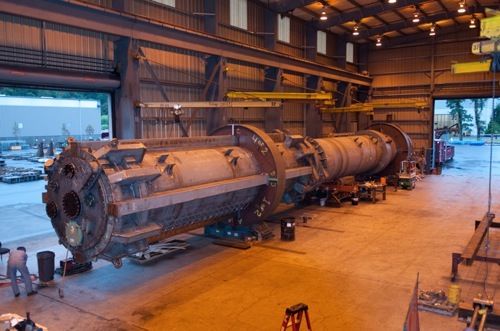
The first buoy will measure 150 feet tall by 40 feet wide, weigh 200 tons and cost $4 million. Nine more buoys are planned to deploy near Reedsport, Ore., by 2012, at a total cost of $60 million. Ocean Power Technologies has contracted with Oregon Iron Works to build the buoys. Clusters of buoys would cover a five-mile stretch, north to south, less than three miles from shore.
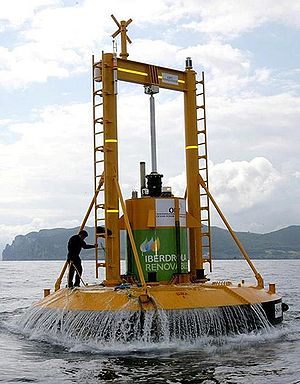
Grays Harbor Ocean Energy plans an offshore wave energy generation platform in shallow coastal waters 2.8 miles off of the Washington towns of Westport and Ocean Shores in Grays Harbor of Washington state.
Whether or not wave energy facilities should be sited inside the newly proposed marine reserves off the Oregon coast is currently a hotly debated topic. The trick is to tap the benefits of a new industry without spoiling ocean habitats, economic livelihoods and recreational playgrounds. Off shore energy policy is still being worked out. No state agency in the U.S has ever permitted a wave energy project.
A wave-power device from another company, Finavera, sank off the Oregon coast two years ago.
Oregon Wave Energy Trust is a nonprofit public-private partnership funded by the Oregon Innovation Council.
Pacific Energy Ventures (Portland, Oregon) will build a Protocol Framework for identifying, collecting and comparing environmental data relevant to offshore renewable energy projects Oregon Wave Trust is designed to serve as a connector for all stakeholders involved in wave energy project development.
Other Oregon wave energy players include Aquamarine, a Scottish company with a technology called The Oyster with an office in Newport, a Scandinavian company, Floating Power Plant and Norway’s Wave Energy A/S in Tillamook looking at a jetty-based device.
Electric Cars
The U.S. has lurched from different transportation energy policies in the past several years, favoring fuel cells and then biofuels and now electrification and hydrogen. How far electrification will go is still unclear. Electric vehicles will reduce green house gases and dependence on foreign oil say advocates.

There are 40 companies building either electric vehicles or component parts, says Drive Oregon. Oregon-made electric vehicles include Arcimoto Brammo, Ryno Motors, Green Lite Motors, MotoCzysz as well as EV Charging Station manufacturers Shorepower and Optimization Technologies. Charging overnight, at non-peak times, helps balance demands on the grid and grid energy storage may help demand spikes.

The Nissan Leaf, an all electric car, is being tested in Portland, as are Chevrolet Volt and Ford's Focus Electric. Plug-in hybrids have much smaller batteries, running perhaps 10-40 miles on electricity before using a gas engine.
Chevrolet's Volt (right) is a plug-in hybrid, since it is not 100% battery powered. It goes about 40 miles on batteries. The best selling Toyota Prius uses a conventional gas engine but runs on a small battery for the first 4-6 miles. The plug-in hybrid Prius has a bigger battery with a 12 mile range. It can be recharged by plugging them in. That's cheaper than using the car's gas-powered generator to charge them up. Zip Car in Oregon is now offering two plug-in Prius cars for $7/hr.
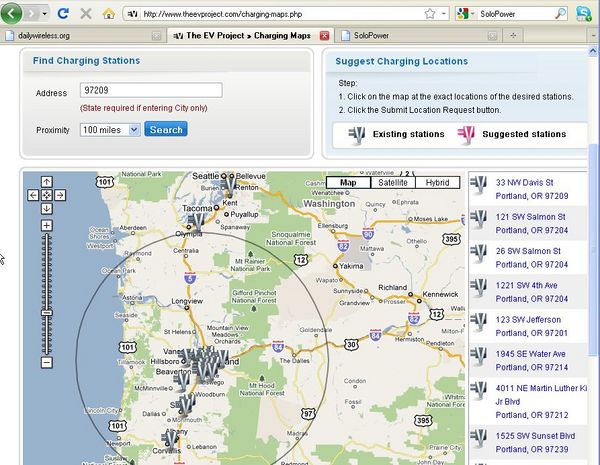
Both the ground breaking Nissan Leaf and the eStar will be limited to a 100 mile range on their Lithium Ion batteries. The Leaf runs only on batteries. When it's out of juice, it's dead. The Nissan Leaf costs $33,000 (before rebates), and has been described as a $16,500 subcompact car that costs double that thanks to a battery estimated to cost $16,500. The Navistar eStar, an electric truck, will sell for $150,000 and totes a battery estimated to cost nearly $75,000.
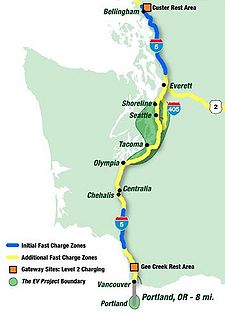
Oregon's Electric Vehicle Charging Network is extending electric car charging stations along the I-5 corridor. It costs only $2-$3 to charge up an all electric car. Electric vehicles keep oil money in the country and may develop a new industry based on innovation - or so the thinking goes.
ECOtality's Fast chargers are available in Portland and Eugene, south to the California border creating a system of electric vehicle (EV) charging stations along the entire length of Interstate 5 in Oregon.
Washington State's Electric Highway project (right), aims to provide enough charge stations to enable longer range traveling. Today's electric cars, typically run out of juice around 100 miles after topped off.
EV4Oregon.com combines Solarworld panels, with Enphase microinverters, battery storage and 220 volt utility feeds to create Electric Vehicle carports that offers Level 1 (30 minute charging) without the expense of a 440 volt line drop. The system claims a 20-minute electric vehicle charging capability by combining battery and 220 volt line power.
The City of Hillsboro is the first in the State of Oregon to install Coulomb Technologies Level II ChargePoint Networked Charging Stations for plug-in and electric vehicles. Thirteen Level II charging stations are now installed in downtown Hillsboro at their new green intermodal transit facility. Portland-based Shorepower Technologies is currently deploying Electrified Parking Spaces (EPS) across North America.
PGE installed the first publicly available fast charger in the United States in the summer of 2010 in its parking garage in downtown Portland. NEC's Takasago Rapid Charging Station complies with the CHAdeMO EV charging standard, and comes in 50kW and 20kW capacities for 15-30 minute charging. A 20 minute quick charger might utilize a 45-kilowatt photovoltaic carport.

ReVolt, with headquarters in Portland, is developing Zinc-Air batteries. Lithium-air is said to be the dream battery. Electric vehicles are anticipated to have a range of 200 to 400 miles in the foreseeable future. Cost/effective batteries, with 2-3 times the present capacity, may largely resolve many range anxiety issues by allowing overnight charging.
The Oregon Electric Vehicle Association gathers true believers while the WestCoastGreenHighway has the latest on charging stations..
Inverters and Electronics
Founded in 2003, PV Powered, based in Bend, designs and manufactures inverters, devices which convert the direct current produced by solar panels into the alternating current supplied by electric utilities. Proponents of micro-inverters believe the technology makes the system more reliable, smarter, and efficient by increasing energy harvesting through optimal MPPT at the module level. Enphase has pioneered this technique and offers online monitoring of your installation. Enecsys 240W micro-inverters are the first without electrolytic capacitors to achieve UL certification. The company claims their 240 watt inverter has an operating life expectancy of greater than 25 years, matching that of solar PV modules.
Alternative Energy Financing
The Oregon Department of Energy has released information about the 2011 application process for the Business Energy Tax Credit. Applications for the next round of "Tier 1" credits opens Jan 3, 2011. For this category, there is $15 million in tax credits available for projects with an estimated cost of less than $500,000.
SolarCity's financing options let homeowners and businesses in Beaverton, for example, switch to solar power with little or no up-front investment; power is sold directly to the utility.
SolarCity expanded its presence in Oregon, offering a lease program to customers of Portland General Electric and Pacific Power. It virtually eliminate upfront costs, allowing homeowners to get rooftop solar panels for as little as $20 per month. The new rules allow customers who choose to lease their solar systems to receive the residential tax credit (RETC) that was previously only available to customers that purchased solar systems. SolarCity then sells the "green" power directly to power companies. The Oregon DOE has details.
A new report from the National Renewable Energy Laboratory (NREL) examines feed-in tariffs (FITs). The policy is known for spurring dramatic growth of renewable energy in Europe during the past decade.
Terry Gross explains Cap and Trade, which allows businesses that go over their carbon "budget" to buy "credits" from business who use less then their allowance of "carbon offsets".
Beaverton's 1000 watt array illustrates how to figure your typical power generation, then compare it with your power bill and total solar installation costs. Grape Solar’s kits retail for 25-30K and provide all the power for an average middle-class home. They're out of Eugene. Without subsidies, which can amount to 75% of the cost, solar has a ways to go to reach parity in the home.
The Treasury Grant Program (TGP) for renewable energy projects was passed in mid December 2010. It extends the cash payment of up to 30% of equipment costs in place of the Investment Tax Credit. The grant program was responsible for a large portion of the renewable energy projects built throughout the U.S. in 2010. Originally passed as part of the 2009 stimulus package, it was supposed to expire at the end of December.
The American Wind Energy Association projected a loss of tens of thousands of wind jobs in 2011 without an extension of the TGP while the Solar Energy Industries Association said the grant program spurred over 1,100 solar projects and $18 billion dollars of investment in 2010.
The power system requires that generation of electricity perfectly matches the amount consumed at all times but wind farms can create excess power, causing waste or environmental impact. Portland General Electric in the next two years plans to install batteries from Ener1 to supply enough juice to power 400 homes in Salem for about an hour. The Electric Storage Association has more on energy storage technologies.
Coal Fired Power
Coal. The United States is the Saudi Arabia of coal. We've got more coal than just about anybody. Today, more than 90 percent of the coal used in America goes to make electricity. Half the electricity generated in the United States comes from coal.

Coal plants generate power for three cents a kilowatt hour. "Clean coal" isn't a type of coal but a process to clean it up, capturing particulates and green-house emitting carbon dioxide. Clean coal costs 6 cents a kilowatt hour. Most renewable projects, like wind and solar, are in the range of 15 to 20 cents a kilowatt hour. In the United States, electricity generation accounts for nearly 40 percent of greenhouse gas emissions, the largest of any source.
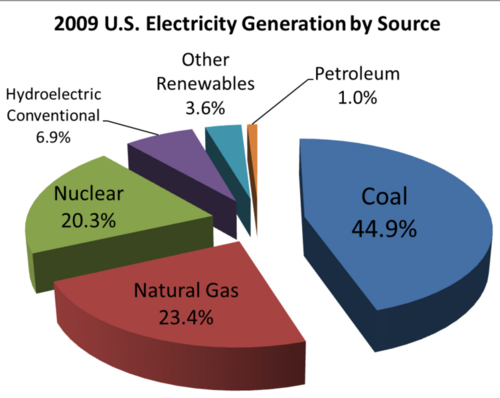
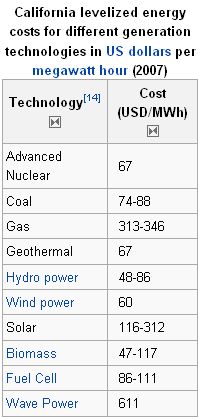
The Boardman coat plant accounts for 15 percent of the power provided by PGE, Oregon's largest electric utility, but Pacific Power share of coal is 40%, according to Washington State's online reports (pdf).
Facebook’s data center in Prineville, Oregon is receiving a “green” backlash since its electric utility, Pacific Power, will likely be getting most of its power from a coal-powered generator in Boardman, Oregon. The company avoided tiered energy rates, due to a formula used by the Bonneville Power Administration, the federal agency that operates dams on the Columbia River and sells the power at cost to utilities. Pacific Power will get most of its electricity from the nearby Boardman coal-fired plant.
Geothermal Power
Geothermal comes from the Greek words meaning earth heat, explains the Oregon Department of Energy.
There is no generation of electricity from geothermal sources within the state of Oregon. However, there are several sites where geological data suggest a resource sufficient for power generation may exist. The potential for production of electricity from Oregon´s geothermal resources has been explored at three sites in Oregon. The DOE in February finalized a $96.8 million loan guarantee to U.S. Geothermal to support their geothermal power project in Malheur County, Eastern Oregon.
The city of Klamath Falls uses geothermal energy directly to supply heat for a district heating system. Geothermal heat sources in several other Oregon counties supply heat to buildings, swimming pools, resorts and industrial uses.

The Port of Portland headquarters is Gold certified and uses geothermal pipes to suppliment heating (above)
Green Buildings
The U.S. Green Building Council is a non-profit working to make green buildings available to everyone and has a list of green buildings.
The City of Portland adopted a green building policy and funded a Green Building Initiative, which is designed to expand market demand and provide technical services and resources for the building industry. The Portland Office of Planning and Sustainability promotes sustainability principles and practices.
The Portland-based International Living Building Institute administers Living Building Challenge, a performance standard more ecologically rigorous than the U.S. Green Building Council's Leadership in Energy and Environmental Design (LEED) Platinum rating.
LEED, or Leadership in Energy and Environmental Design, was started in 2000 and initially was used in the construction of office buildings. The LEED for Homes program is tailored to the needs of single-family construction. Cascadia Green Building Council lists Some LEED buildings around the Portland region. Green building represents a nearly $50 billion industry in the United States and is projected to grow significantly.

The Oregon Sustainability Center (above), planned for the Portland State campus, is aiming for triple net-zero performance in energy, water and carbon emissions.
Vestas, the world’s largest wind turbine maker, will convert the former Myer and Frank warehouse in Portland, into its new North American headquarters. It will be designed by Gerding Edlen and is shooting for LEED Platinum. Gerding Edlen has been a pioneer in green building development with dozens of Platinum and Gold certified buildings in Portland.
The Smart Grid
The Smart Grid is an enhancement to the power grid that delivers electricity from suppliers to consumers using two-way communications to control appliances. When power is least expensive the user can allow the smart grid to turn on selected appliances. A Home Area Network ties into the "smart meter", using powerline or RF standards such as ZigBee, INSTEON, Zwave, WiFi and others.
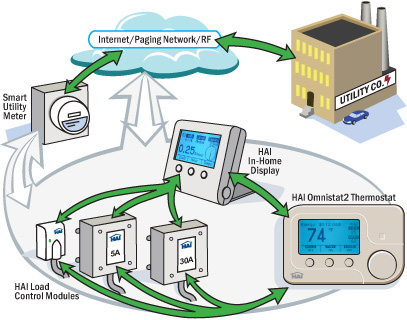
The $178 million Pacific Northwest Smart Grid Demonstration Project is one of 16 regional smart grid demonstration awards announced by DOE in the fall of 2010. It contains key functions of the future smart grid. The project team will install equipment and technology now through mid-2012. Then, for about the next two years, project leaders will gather data on smart grid performance.
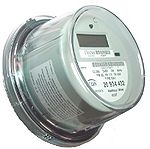
PGE’s new system is a two-way wireless fixed network. It features 46 collectors positioned throughout a 4,000-square-mile service territory. By September, 2010, PGE had rolled nearly 700,000 meters for automated reading. PGE's advanced metering infrastructure, was purchased from Sensus Metering.
According to Venture Beat, there's a battle of standards between companies such as SmartSynch, promoting public network communications, and those endorsing private networks, such as Trilliant and Silver Spring to connect the Smart meter to the power company. There's also a battle of standards to connect devices inside the home.
The Smart Grid Interoperability Panel, a public-private group, has voted for a new standard for two-way data communications between utilities and their customers, recently, bringing the next-generation "smart" electrical power grid a step closer to reality.

The Pacific Northwest National Laboratory, near Richland, will manage PGE's "Smart Meter" project at their Electricity Infrastructure Operation Center. A smart electrical power grid could decrease annual electric energy use and utility sector carbon emissions at least 12 percent by 2030, according to a report from PNNL.
Solar Projects
Portland's Climate Action Plan includes a directive to purchase or generate 100 percent of electricity for city operations from renewable sources, with at least 15 percent of that generated on-site or in-district using renewable energy sources such as solar and bio gas.
The City of Portland’s Solar America Cities project will pursue solar market transformation for Portland residents, businesses, and city operations. Project partners work with other city bureaus to streamline city-level regulations for contractors, homeowners, and businesses. The city will use its influence as a regulator, educator, and motivator to reach the larger regional community.
Portland has partnered with Solar America Communities and started their own, “Solar Now!” organization. People in the community are volunteering their time to help bring solar into as many homes as possible. Solarize Portland provides information to Portland residents on who to hire, what to buy, and what to budget.
Portland Water Bureau Meter Shop has a 12 KW solar array, the largest system entirely owned by the City of Portland. Portland’s solar-powered parking meters were supposed to lower maintenance costs of jammed coin operated meters while maximizing income. Solar panels were installed on the south façade and roof of Brewery Blocks Building #4 in Portland's Pearl District.
Vernier Software produces 19,000 KW hours each year and helps to educate the community about solar energy through their website www.vernier.com/solar. Lucky Labrador Brewing installed solar panels to heat the water during the brewing process for a total cost of $4,460 after all of the tax credits. Now they have broken even with their install costs and are saving an additional $1,560 per year in gas costs.
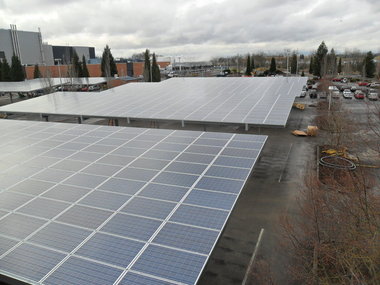
Intel has three, 400 kilowatt solar arrays in Hillsboro. Already the nation's largest buyer of green power, Intel plans to buy 2.5 billion kilowatt hours of renewable energy credits this year, a 75 percent increase over 2010. Intel last year completed eight solar energy projects at its plants in four states. Among them were two 400-kilowatt systems atop raised support structures within the parking lots of its Jones Farm and Ronler Acres campuses in Hillsboro.
Ethanol and Biodiesel
The United States is the world's largest producer of ethanol fuel since 2005 Wikipedia. The U.S. produced 10.6 billion U.S. liquid gallons of ethanol fuel in 2009, and together with Brazil, both countries accounted for 89% of the world's production in that year. Ethanol fuel is mainly used in the U.S. as an oxygenate to gasoline in the form of low-level blends, and to a lesser extent, as fuel for E85 flex-fuel vehicles. Most ethanol fuel in the U.S. is produced using corn as feedstock.
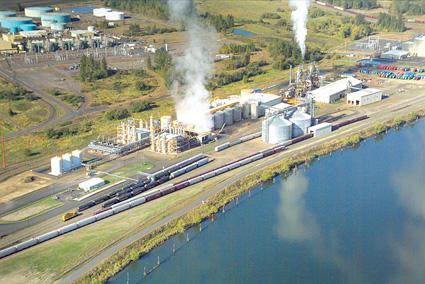
The Cascade Grain Products ethanol plant in Clatskanie (above), out of bankruptcy, sat dormant for nearly two years. Now the new owner hopes to attract a buyer for a working ethanol plant. Cascade Grain filed for Chapter 11 bankruptcy in January, just seven months after it opened the Clatskanie plant, the state’s largest ethanol production facility.
Corn ethanol, widely tooted as a viable alternative energy approach ten years ago, has not achieved the success its backers hoped. The costs of producing corn ethanol were high, it required too much land and the benefits were slim.
Cellulosic ethanol has one ingredient that Oregon has plenty of -- wood. It is now being examined as a competitive energy resource, but currently it requires extra financial support to develop the infrastructure necessary to the technology. Woodchips and the byproducts of lawn and tree maintenance are some of the more popular cellulosic materials for ethanol production. By contrast, corn ethanol most frequently uses natural gas to provide energy for the process, and may not reduce GHG emissions at all depending on how the starch-based feedstock is produced, says Wikipedia.
Biodiesel refers to a vegetable oil- or animal fat-based diesel fuel. Biodiesel is meant to be used in standard diesel engines and is thus distinct from the vegetable and waste oils used to fuel converted diesel engines. Biodiesel can be used alone, or blended with petrodiesel. Biodiesel that is 100% (unblended) is referred to as B100, while 20% biodiesel is labeled B20. B100 generally cost more than petrodiesel except where local governments provide a tax incentive or subsidy.
In 2007, Imperium Renewables of Seattle built a biodiesel plant at the Port of Grays Harbor that hoped to produce as much as 100 million gallons of biodiesel fuel made from plants and vegetable material annually. The market dried up. It is the largest production facility in the United States and the second largest facility overall.
The SeQuential Web site (www.sqbiofuels.com) lists biodiesel sites and about 60 Oregon businesses and agencies with biodiesel-powered fleets --wineries, landscapers, contractors, the Eugene public works department, Cross Creek Trucking, Metro, Powells .com, Hoodoo ski resort, and groundskeeping vehicles at Reed College.
The community aspect of biodiesel attracts many people, and those folks should contact biodiesel cooperatives such as Portland's GoBiodiesel Cooperative, Green Drop Garage, Flower Power Biodiesel Co-op in Salem or Grease Works! in Corvallis. GoBiodiesel Cooperative makes about 200 gallons a month and is in full fundraising mode to build a new plant that will at least quadruple output. Members pay about $2.25 per gallon, plus a one-time $100 membership fee.
What Can I Do to support the Green industry and Alternative Energy?
We can simply waste less. Poor insulation, inefficient appliances and wasteful habits send lots of energy up the chimney. The desire to buy stuff that doesn't really make us happy, doesn't help. Common sense and passion can go a long way.
There are many positive trends. Solar power is becoming more efficient and localized, buildings are getting greener and more self-sufficient, vehicles are getting electrified and using less fossil fuel, and people are more aware of their impact.
There are as many ways to become engaged as there are people.
More Information
Energy Trust of Oregon provides cash incentives for customers of PGE, Pacific Power, NW Natural and Cascade Natural Gas. The Oregon Department of Energy has more information on sustainable energy programs.
Editor Notes
- Hi Samc. I didn't put it together that you're the same "Sam" as the primary editor of PortlandWiki's excellent and highly informative Green industry page until Kotra clued me in on that fact at the conclusion of yesterday's Barnraising event. Hope you can attend one or more upcoming Monday Meets or Portland WikiWednesday meetups.
- Until then, just a quick note on the "references" section added below. Often times, readers of wiki article might find it easier to navigate to outside links that an article refers to by clicking on a footnote reference link (eg:[7]). I've reformatted the first several external links from Green industry to external sources to show how this could work in this article. When you have the chance, please tell me what you think. Thanks! -WikiMaster (talk) 10:55, 6 March 2011 (PST)
- Hi WikiMaster. Thanks for the example. I was wondering how to do it! - Sam
References
External Links
- 85+ Wind and Solar Energy Companies now in Greater Portland, Ore.
- Portland Tribune: Sustainable Life
- SustainableBusinessOregon.com
- Oregon Energy Links
- Sustainable Business Network of Portland
- TheGreenEconomy.tv
- OBP: Ecotrope
- Portland Tribune: China Connection
- City of Portland Energy Policy
- Solarize Portland
- Portland's Ecoroof Program
- Portland's Solar Energy Program
- Oregon Resources: Green Building
- Green Building Council
- Oregon Geothermal
- Oregon Dept of Energy
- Sustainable Oregon Business
- Energy Trust of Oregon
- State Incentives for Alternative Energy
- American Wind Energy Association
- PV-Tech News
- DriveOregon.org
- AutoBlog Green
- Oregon's Electric Vehicle Charging Network
- Columbia Gorge Energy Tour (Flickr)